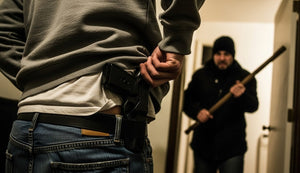When an attacker’s just inches from you, there’s no time to think—only to react. In close quarters, you can’t rely on perfect range form or clean draw lines. You need instinct, training, and tools that won’t fail under pressure.
Whether you’re a military operator, law enforcement officer, or just someone serious about home defense, Close Quarter Combat (CQC) is a discipline worth understanding and preparing for.
What does CQC mean in the real world? It’s what happens when someone grabs your shirt, rushes your home, or catches you off-guard in a parking lot. Can you protect yourself and stay in control?
Let’s break down CQC as it relates to real-world handgun defense, and how to train smarter, gear better, and move with purpose in the moments that matter most.
What Is Close Quarter Combat (CQC) in the Civilian Context?
CQC refers to combat at extreme proximity, usually under 10 feet, often within arm’s reach. For civilians and law-abiding gun owners, it translates to tactical handgun defense in tight, high-pressure scenarios: inside your home, in a hallway, in a car, or a mugging situation.
When you are shooting from distance your main concern is accuracy. When in high stress situations where the threat is close, the ability to act quickly becomes crucial. That’s why CQC focuses on:
-
Rapid threat identification
-
Weapon retention under duress
-
Movement and positioning in confined spaces
-
Striking and defensive use of force if needed
-
Drawing from concealment in compromised positions
This is not a theory. These are the dynamics you face when a bad situation turns physical and fast.
When Every Second Counts
In real-world tactical scenarios, there’s no luxury of distance. It’s you, your training, your awareness, and what’s right in front of you. Close quarter combat (CQB) is high-stress, high-stakes, and happens faster than most people expect.
It's not just about what you do, but also how quickly you can do it, how precisely you can perform under pressure, and how much trust you can place in your gear.
Core Principles of CQB:
-
Speed: Move quickly and decisively without overextending.
-
Surprise: Use light, angles, and movement to disorient the threat.
-
Violence of action: When necessary, commit fully and overwhelm.
-
Communication and clarity: Especially important for team-based CQB
Why CQC Matters for Everyday Gun Owners
You won’t always have the luxury of distance. Most civilian defense scenarios unfold at 7 feet or less, and often start with verbal escalation or physical aggression. In that range, speed and control become crucial Your attacker may be moving, grabbing, or actively trying to disarm you.
The goal is to survive. That means knowing how to:
-
Keep control of your weapon
-
Create enough space to draw and act
Use your body and environment to your advantage -
Neutralize the threat while minimizing legal fallout
Training for close quarters is one of the smartest things you can do to prepare for real-world violence.
Key CQC Handgun Techniques You Should Practice
The Combat Draw
This isn’t your typical range draw. The combat draw is about a tight, compressed motion that keeps the weapon close to your torso and away from an attacker’s reach. Focus on drawing to the retention position—firing from the chest or hip if needed.
Weapon Retention Drills
In close quarters, your gun is a target. Learn how to keep your firearm tight to your body, use your support hand to fend off attackers, and control the muzzle direction no matter the struggle.
Striking + Shooting Transitions
If you need to strike—palm, elbow, knee—it should flow into your draw. Train for integrated responses: strike, create space, draw, shoot.
Movement and Angling
Don’t be a static target. Practice sidestepping, pivoting, and using walls, doors, or even your car to your advantage. Movement creates time. Time creates survival.
Your Gear Matters: Holster Choice Can Save Your Life
In CQC, gear can be the difference between control and disaster. A poor-fitting holster, a snagged draw, or a compromised trigger can ruin your response.
That’s why we recommend using holsters specifically designed for high-pressure conditions. And if you are looking for the best ones, then you are in luck: at 45 Blast we have top tier Kydex-based holsters. These are built with precision, retention, and real-world movement in mind.
What makes a good holster for CQC:
-
Trigger guard coverage: Prevent accidental discharge during a struggle
-
Secure retention: Keeps your gun in place through motion and resistance
-
Quick, smooth draw: No unnecessary clicks, snaps, or catches
-
Minimal printing: For concealed carry and discretion
-
Comfort + adaptability: You want something you’ll actually wear daily
Situational Training: Practice How You Live
Don’t just train for the range. Train for your hallway. Your bedroom. Your car.
Close-quarter tactics are only useful if they’re trained in realistic environments. That’s why many experts recommend scenario-based practice.
Think dry runs inside your home, or classes that simulate tight, dynamic confrontations.
Consider enrolling in CQC or personal defense workshops that focus on live movement, retention, and rapid judgment. One example: M1 Tactical’s CQB course, which provides intensive close combat training for real-world application.
You can also find solid breakdowns on YouTube from vetted instructors like Garand Thumb or Warrior Poet Society, who specialize in close-in tactics with a firearms focus.
Mindset First: Confidence Over Cool
Too many new gun owners focus on gear, drills, and tactics, and forget the most critical piece: mindset.
If you freeze, panic, or hesitate, none of your gear matters. CQC training isn’t just about shooting. It’s about decision-making, clarity under pressure, and emotional control.
This means:
-
Accepting that violence may happen
-
Training your nervous system to stay calm
-
Drilling responses until they’re second nature
-
Always thinking ahead: where am I, who’s nearby, what’s my plan?
You don’t need to be aggressive. You need to be aware, assertive, and ready.
Mistakes to Avoid in CQC Situations
Even experienced shooters can mess up in close quarters. Here are some common pitfalls:
-
Overextending your arms: Gives the attacker a lever to grab
-
Assuming too much time: You might have seconds—or less
-
Using flashy tactics: Stick to what works, not what looks good on YouTube
-
Ignoring legal aftermath: Know your state’s laws on lethal force
-
Neglecting your fitness: Strength, mobility, and cardio all help in a fight
Learn CQC and Control the Chaos
CQC with a handgun is all about survival. It’s about staying one step ahead when the space is tight, the timeline is short, and the stakes are sky-high.
You don’t need to be a SEAL or a SWAT officer to move smart and train right. You just need the right mindset, gear that won’t fail, and a commitment to prepare for the fight you hope never comes.
Train close. Carry smart. And remember: your stance, your gear, and your decisions all stack toward one goal—staying alive.
Ready to Upgrade Your CQC Setup?
Explore 45 Blast’s Kydex holsters and Canik comps to level up your carry system. Designed by shooters, for shooters. Trusted by professionals and weekend range warriors alike.


